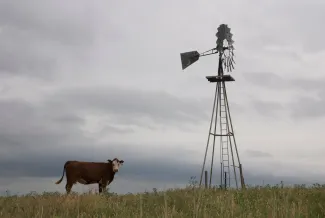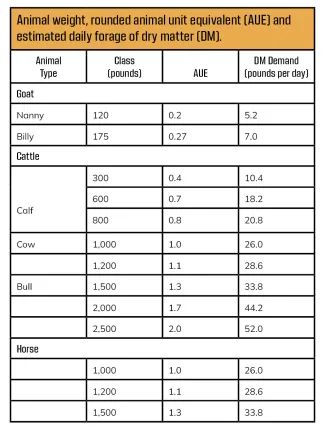
Prescribed grazing is perhaps the most utilized management tool on both private and public landholdings. It is commonly used to improve or maintain the quantity and quality of forage for livestock. But prescribed grazing can also benefit several species of wildlife – including northern bobwhite. Grazing removes the old growth (thatch) which creates more palatable forage for livestock the following year and increases bare ground for foraging birds. If this old growth isn’t removed, it can shade out or limit new vegetative growth during the growing year which in turn reduces overall livestock gains.
Setting the correct stocking rates is essential when developing a prescribed grazing plan. Simply put “stocking rates balance the needs of the plants with the needs of the animals.” Because stocking rates are based on the amount of forage available each year – which is directly affected by climate and soils – stocking rates should be re-evaluated each year.
Determining the amount of available forage is the first step in setting stocking rates. There are several methods producers can use to obtain the amount of forage available on their property. Some producers use guesswork from previous years or previous grazing plans. Others obtain soil surveys from the Natural Resources Conservation Service Ecological Site Descriptions. Each ecological site reflects the soil depth, topography, slope, plant production, and species composition of an area. The easiest way to calculate the available forage is by installing 8’X8’ fenced grazing exclosures. These exclosures allow the grass to grow without grazing pressure. At the end of the season, clip and weigh the vegetation within the exclsoure. Exclosures should be moved each year during the winter. Standing crop information obtained from past years – the more the better – will aid in better decision making on stocking rates.
The next step for setting a stocking rate is to calculate the amount of livestock utilization by estimating the amount of forage left standing at the end of the growing season (September through October). While the “take half, leave half” concept is commonly accepted in range management, it may be misleading. Fifty percent should indeed be utilized, but livestock consumption should only represent about 25 percent of utilization. It should be expected that the other 25 percent will be laid on, trampled, or consumed by other species such as insects or wildlife.
Stocking rates will vary depending on the type of grazing system used. The best grazing system for one property may not work for other properties in other vegetation types. Livestock type (cow-calf pairs, stockers, etc.) and the time and duration of the grazing event (seasonal, year-round, etc.) affect stocking rates.
Stocking rates can also vary depending on the type of livestock and its size. This factor is expressed by Animal Units (AU) per unit of land area. The most common animal unit is a 1,000-pound dry cow and represents 1 AU. The estimated dry forage required for this 1,000-pound cow (1 AU) is 26 pounds per day. Different livestock and their sizes have different animal unit equivalents (AUE).
As an example, landowner “Bob White” has 1,000 acres of native tall grass prairie and wants to know how many 1,000-pound dry cows he can graze on the property. At the end of the growing season, he clipped and weighed the vegetation within his grazing exclosures. He found the end of the season standing crop was 6,360 pounds per acre. Bob White wants to graze from May 1 to September 30, or 150 days.
From the information about animal unit equivalents, we know that a 1,000-pound dry cow is considered 1 animal unit. We also know that in order to “take half, leave half” only 25 percent of the available forage can be consumed by livestock. Using the following formula, we find that Bob White can graze 407 cows on his 1,000-acre property for 150 days.
Formula:
(Total Land Area) X (Average End of Season Standing Crop) X (Forage Utilization)
divided by
(AU Forage Demand per AU per day) X (Animal Unit Equivalent) X (Number of Days Grazed)
Example:
(1,000 acres) X (6,360 pounds per acre) X (0.25 or 25%)
(26 pounds per day) X (1 AU) X (150 days)
=
1,590,000
3,900
=
407 cows

With proper stocking rates, a landowner can see a positive livestock response and benefit wildlife and their habitat. Grazing is a useful tool that can be used in a wildlife management plan to reduce old growth and increase new vegetation growth. For more information about prescribed grazing, contact your local wildlife biologist or NRCS office or read OSU Fact Sheet NREM-2886 on Stocking Rate Determination on Native Rangeland.